"X-Men: The Last Stand" - Movie Review
 X-Men: The Last Stand 2006
X-Men: The Last Stand 2006 Or, this is the way to ruin a movie franchise. Back in 1963, when the world was young and gay, comic book legends Stan Lee and Jack “King” Kirby co-created a superhero group comprised of a group of teenagers ostracized by a society that feared their differences. And how where they different?
Or, this is the way to ruin a movie franchise. Back in 1963, when the world was young and gay, comic book legends Stan Lee and Jack “King” Kirby co-created a superhero group comprised of a group of teenagers ostracized by a society that feared their differences. And how where they different? Well, one shot laserbeams out his eyes, one turned to ice, one flew on a pair of giant wings, one crawled around on all fours and the sole gal of the team read minds and levitated objects. They were gathered together by an egghead telepath confined to a wheelchair and they vowed to make their people proud by defending the world from evil doers.
Well, one shot laserbeams out his eyes, one turned to ice, one flew on a pair of giant wings, one crawled around on all fours and the sole gal of the team read minds and levitated objects. They were gathered together by an egghead telepath confined to a wheelchair and they vowed to make their people proud by defending the world from evil doers.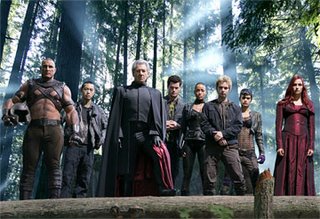 The “X-Men” as they came to be known, fought mutated super-villains like Magneto and his Brotherhood of Evil Mutants (Nice name for a coterie of super-villains, don’t you think? Subtle.) and their own second rate status which brought diminishing sales figures throughout the years, never rivaling their more famous Marvel Comics brethren: The Fantastic Four, The Avengers or their high flying solo heroes, Spider-man, Daredevil, etc.
The “X-Men” as they came to be known, fought mutated super-villains like Magneto and his Brotherhood of Evil Mutants (Nice name for a coterie of super-villains, don’t you think? Subtle.) and their own second rate status which brought diminishing sales figures throughout the years, never rivaling their more famous Marvel Comics brethren: The Fantastic Four, The Avengers or their high flying solo heroes, Spider-man, Daredevil, etc.  Faced with near cancellation, they reinvigorated their comic book franchise in the early 1970s by restructuring the group with a new band of mutant misfits, seemingly plucked from a Junior UN assembly. Suddenly we encountered mutants who not only had extraordinary powers, but who hailed from . . . gasp! Abroad. Storm, from Africa with her control over the elements. Nightcrawler, from Germany whose outwardly demonic appearance belied his fun loving interior. Thunderbird, a proud Native American mutant powerhouse who lasted all of two missions prior to being blown up. And of course, the hero who soon grew to become one of the most popular of comic book icons, Wolverine from Canada, a crusty beer swilling sociopath with an Adamantium skeleton and razor sharp claws ready to disembowel anybody who got in his way.
Faced with near cancellation, they reinvigorated their comic book franchise in the early 1970s by restructuring the group with a new band of mutant misfits, seemingly plucked from a Junior UN assembly. Suddenly we encountered mutants who not only had extraordinary powers, but who hailed from . . . gasp! Abroad. Storm, from Africa with her control over the elements. Nightcrawler, from Germany whose outwardly demonic appearance belied his fun loving interior. Thunderbird, a proud Native American mutant powerhouse who lasted all of two missions prior to being blown up. And of course, the hero who soon grew to become one of the most popular of comic book icons, Wolverine from Canada, a crusty beer swilling sociopath with an Adamantium skeleton and razor sharp claws ready to disembowel anybody who got in his way.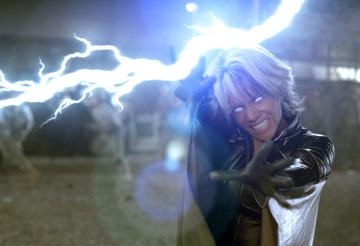 When the movies decided to visit the “X-Men”, they found their savior in the talents of Bryan Singer, whose success with “The Usual Suspects” brought him at the tender age of thirty international acclaim. Overhyped acclaim in our opinion, but there it was. After originally rejecting the offer to bring the superhero mutants to the silver screen, Mr. Singer did a little research and realized that they were indeed a worthwhile subject to play with. The only problem was that the studio didn’t want to invest too much money into the project, so they slashed the budget to a paltry $60M, and bid him good luck.
When the movies decided to visit the “X-Men”, they found their savior in the talents of Bryan Singer, whose success with “The Usual Suspects” brought him at the tender age of thirty international acclaim. Overhyped acclaim in our opinion, but there it was. After originally rejecting the offer to bring the superhero mutants to the silver screen, Mr. Singer did a little research and realized that they were indeed a worthwhile subject to play with. The only problem was that the studio didn’t want to invest too much money into the project, so they slashed the budget to a paltry $60M, and bid him good luck.
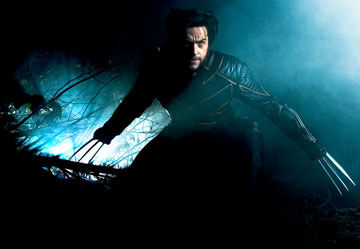 Opting to focus on a strong cast of below the marquee name actors, and relying on mood and characterization – Bryan Singer pulled off the near impossible. An entertaining, action adventure based on a comic book that indeed managed to tell a good story without resorting to overkill action sequences and a preponderance of special effects. The sequel “X2” was an even bigger success. And then came the third part of the trilogy. Bryan was all set to direct, but an offer to go play with the big boys over at the re-imagining of the Superman franchise was too good to pass up. So who did the studio turn to as a replacement?
Opting to focus on a strong cast of below the marquee name actors, and relying on mood and characterization – Bryan Singer pulled off the near impossible. An entertaining, action adventure based on a comic book that indeed managed to tell a good story without resorting to overkill action sequences and a preponderance of special effects. The sequel “X2” was an even bigger success. And then came the third part of the trilogy. Bryan was all set to direct, but an offer to go play with the big boys over at the re-imagining of the Superman franchise was too good to pass up. So who did the studio turn to as a replacement?
 Brett Ratner. Now, if some of you don’t know who Brett Ratner is, you should stand up and pat yourself on the back. For this sixth tier hack is the director of “Rush Hour” and “Rush Hour 2” – and of course, the upcoming “Rush Hour 3”.
Brett Ratner. Now, if some of you don’t know who Brett Ratner is, you should stand up and pat yourself on the back. For this sixth tier hack is the director of “Rush Hour” and “Rush Hour 2” – and of course, the upcoming “Rush Hour 3”.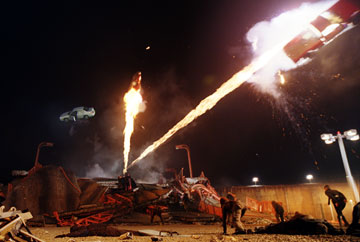 What Brett Ratner does to the ingenuity and loving care lavished on the muties by Bryan Singer on the first two X-Men films, is cinematically parallel to a slow and grisly rape, torture dismembering and murder. Whatever hope we had upon entering the theatre was killed within the first ten minutes of his slapdash filmmaking. Here is a film that is so overripe with false atmosphere, truncated characterizations, cheap theatrics, below the borscht belt humor and noisy trainwreck fight scenes it makes you long for the artistry of “Poseidon”.
What Brett Ratner does to the ingenuity and loving care lavished on the muties by Bryan Singer on the first two X-Men films, is cinematically parallel to a slow and grisly rape, torture dismembering and murder. Whatever hope we had upon entering the theatre was killed within the first ten minutes of his slapdash filmmaking. Here is a film that is so overripe with false atmosphere, truncated characterizations, cheap theatrics, below the borscht belt humor and noisy trainwreck fight scenes it makes you long for the artistry of “Poseidon”.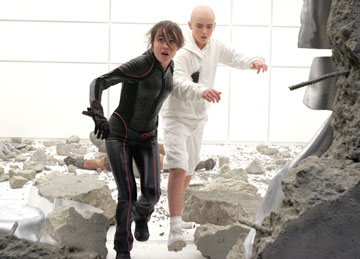 The major plot point which is workable enough is the government’s paranoia over “the mutant issue”, exacerbated by the discovery of a new mutant, codenamed Leech who has the power to drain the mutant gene into nonexistence. Although this point isn’t articulated or displayed in a very consistent manner. And unfortunately for the young actor, Cameron Bright of “Birth” fame, Leech has very little to do but look perplexed at his clinical prison surroundings on the refurbished Alcatraz.
The major plot point which is workable enough is the government’s paranoia over “the mutant issue”, exacerbated by the discovery of a new mutant, codenamed Leech who has the power to drain the mutant gene into nonexistence. Although this point isn’t articulated or displayed in a very consistent manner. And unfortunately for the young actor, Cameron Bright of “Birth” fame, Leech has very little to do but look perplexed at his clinical prison surroundings on the refurbished Alcatraz.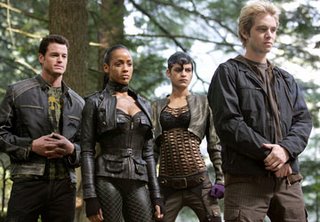 Now much has been made of the parallels between “mutants” and other undesirables of society. Namely the Gays. Yes, we suppose one could drive home a distinct comparison between being born different into a homogenized world that fails to recognize the inherent naturalness of being an “other”. We also suppose that “mutants” could stand in for biker culture, as displayed by the wandering band of evil mutants that the main villain, Magneto has gathered around him. Gay biker mutants? Where’s that film?!
Now much has been made of the parallels between “mutants” and other undesirables of society. Namely the Gays. Yes, we suppose one could drive home a distinct comparison between being born different into a homogenized world that fails to recognize the inherent naturalness of being an “other”. We also suppose that “mutants” could stand in for biker culture, as displayed by the wandering band of evil mutants that the main villain, Magneto has gathered around him. Gay biker mutants? Where’s that film?!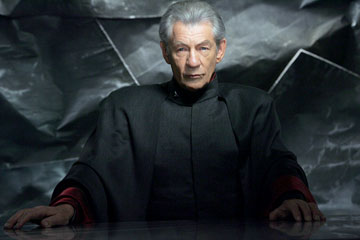 Amongst the cast of thousands, a few of the returning players manage to avoid getting completely buried in the celluloid dungheap. Dame Ian McKellen (who valiantly attempted to save “The Da Vinci Code” from its withering drudgery) returns as Magneto, the evil master of magnetism.
Amongst the cast of thousands, a few of the returning players manage to avoid getting completely buried in the celluloid dungheap. Dame Ian McKellen (who valiantly attempted to save “The Da Vinci Code” from its withering drudgery) returns as Magneto, the evil master of magnetism.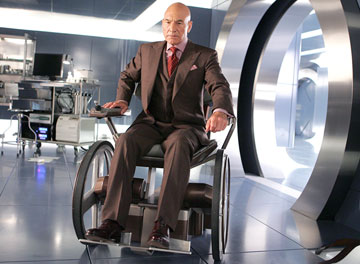 Patrick Stewart’s substantial acting chops are again on display as the mentor to the good mutants, Professor Charles Xavier.
Patrick Stewart’s substantial acting chops are again on display as the mentor to the good mutants, Professor Charles Xavier. Famke Janssen, who deserves better material is resurrected from her untimely death in the second film to emerge as a psychotic power mad re-mutated mutant . . . whew, try typing that kids! Not so subtly renamed Phoenix. Apparently, returning from the dead as the most powerful mutant in existence makes a gal rather horny.
Famke Janssen, who deserves better material is resurrected from her untimely death in the second film to emerge as a psychotic power mad re-mutated mutant . . . whew, try typing that kids! Not so subtly renamed Phoenix. Apparently, returning from the dead as the most powerful mutant in existence makes a gal rather horny.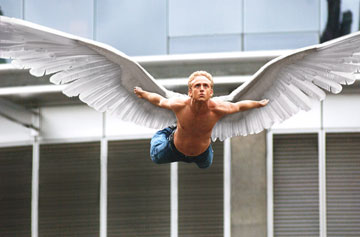 As for the new mutants on the block, Ben Foster clearly has spent some time at Crunch preparing for his debut of the Angel character. More is the pity that his role pretty much ends up on the cutting room floor.
As for the new mutants on the block, Ben Foster clearly has spent some time at Crunch preparing for his debut of the Angel character. More is the pity that his role pretty much ends up on the cutting room floor.
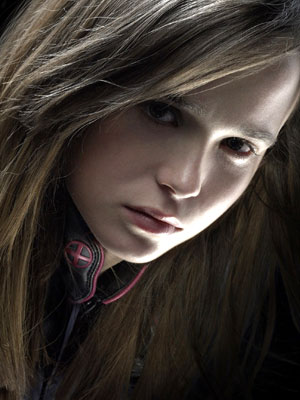 Ellen Page, who cleverly and manipulatively fought off a charming child molester in the interesting "Hard Candy" recently, is the third actress to portray the intangible Kitty Pryde. Credit her for at least attempting to bring some sparkle and humor to the thankless role.
Ellen Page, who cleverly and manipulatively fought off a charming child molester in the interesting "Hard Candy" recently, is the third actress to portray the intangible Kitty Pryde. Credit her for at least attempting to bring some sparkle and humor to the thankless role.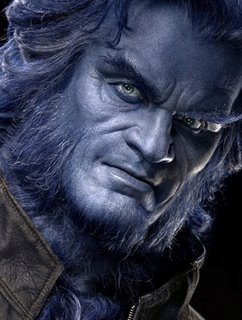 And as the ridiculously hirsute, blue toned to be specific - Beast - a character that is both brawn and brains, TV's own Dr. Frasier Crane emerges as one of the more interesting new mutants. He bravely attempts to ground his laughably outfitted character and damn near succeeds. If it weren't for the poisoned lens of Brett Ratner, he might have.
And as the ridiculously hirsute, blue toned to be specific - Beast - a character that is both brawn and brains, TV's own Dr. Frasier Crane emerges as one of the more interesting new mutants. He bravely attempts to ground his laughably outfitted character and damn near succeeds. If it weren't for the poisoned lens of Brett Ratner, he might have.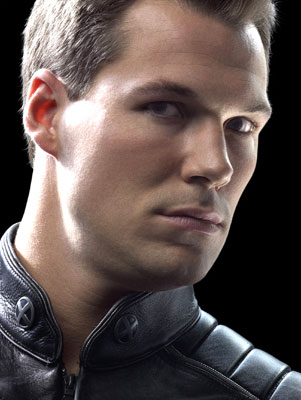 But by far the most interesting "new" character is one glimpsed briefly in the last X-episode, Daniel Cudmore as the metallic-skinned-morphing-muscleman Colossus. Whew! What a slab of metalloid hunk! We'd gladly take a shine to his bumper grill anyday. Yowza.
But by far the most interesting "new" character is one glimpsed briefly in the last X-episode, Daniel Cudmore as the metallic-skinned-morphing-muscleman Colossus. Whew! What a slab of metalloid hunk! We'd gladly take a shine to his bumper grill anyday. Yowza.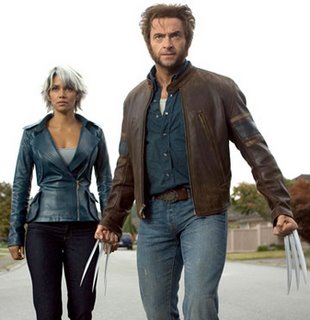 Of the returning heroes, Hugh Jackman as Wolverine and Halle Berry as Storm form the backbone to the mutant family. And you know when your film relies on the acting talents of Halle Berry and the masculinity of Hugh Jackman, you’re already in trouble. At least her wig is slightly better this time around. Less High School production, more Raquel Welch.
Of the returning heroes, Hugh Jackman as Wolverine and Halle Berry as Storm form the backbone to the mutant family. And you know when your film relies on the acting talents of Halle Berry and the masculinity of Hugh Jackman, you’re already in trouble. At least her wig is slightly better this time around. Less High School production, more Raquel Welch. Perhaps part of the problem with the “X-Men” franchise, is that unless you are one of the ten fanboys in the audience that have memorized the past forty plus years of comic book storylines, it is near impossible to understand or care about the many mutants paraded in front of you. As we understand it, the “Dark Phoenix” storyline involving the death, resurrection and ultimate sacrifice of the telepath cum powerhouse Jean Grey character is amongst the most famed and revered of superhero tales. Here, it is sandwiched into the proceedings with all the care and reverence of a throwaway gay-teen-contemplates-suicide subplot on “Days of Our Lives”.
Perhaps part of the problem with the “X-Men” franchise, is that unless you are one of the ten fanboys in the audience that have memorized the past forty plus years of comic book storylines, it is near impossible to understand or care about the many mutants paraded in front of you. As we understand it, the “Dark Phoenix” storyline involving the death, resurrection and ultimate sacrifice of the telepath cum powerhouse Jean Grey character is amongst the most famed and revered of superhero tales. Here, it is sandwiched into the proceedings with all the care and reverence of a throwaway gay-teen-contemplates-suicide subplot on “Days of Our Lives”. The film has so many moments of needlessly throwaway scenes that even simple continuity errors like a climactic battle scene suddenly going from day to night in a split second only serve to wake us from our stupor with a casual giggle. In a better movie, we might have forgiven the mistake. In this trashpile, it only serves to underscore the limited vision and utter lack of talent on the director’s part.
The film has so many moments of needlessly throwaway scenes that even simple continuity errors like a climactic battle scene suddenly going from day to night in a split second only serve to wake us from our stupor with a casual giggle. In a better movie, we might have forgiven the mistake. In this trashpile, it only serves to underscore the limited vision and utter lack of talent on the director’s part.
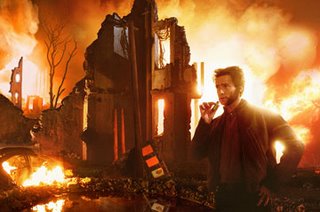 By attempting to introduce at least a dozen new mutants into the latest X-tale all the while maintaining that this episode will be the last one, the moviemakers – and we use the term loosely – fail to focus on any of them long enough for us to give a shit. Of course if you stay long enough for the end credits, a not so subtle coda makes it explicitly clear that not even death can keep the mutants down. “Last Stand”, our collective asses! By this point, we were so weary from the amateur goings on that we honestly viewed any possibility of another X-film as a direct threat on our shattered cinematic sensibilities. Dear Brett Ratner, go to hell and stay there. Bless you all!
By attempting to introduce at least a dozen new mutants into the latest X-tale all the while maintaining that this episode will be the last one, the moviemakers – and we use the term loosely – fail to focus on any of them long enough for us to give a shit. Of course if you stay long enough for the end credits, a not so subtle coda makes it explicitly clear that not even death can keep the mutants down. “Last Stand”, our collective asses! By this point, we were so weary from the amateur goings on that we honestly viewed any possibility of another X-film as a direct threat on our shattered cinematic sensibilities. Dear Brett Ratner, go to hell and stay there. Bless you all!
Directed by Brett Ratner
Written by Simon Kinberg & Zak Penn
Starring
Hugh Jackman as Wolverine / Logan
Halle Berry as Storm / Ororo Munroe
Ian McKellen as Magneto / Eric Lensherr
Famke Janssen as Phoenix / Dr. Jean Grey
Anna Paquin as Rogue / Marie
Kelsey Grammer as Beast / Dr. Hank McCoy
Rebecca Romijn as Mystique / Raven Darkholme
James Marsden as Cyclops / Scott Summers
Shawn Ashmore as Iceman / Bobby Drake
Ben Foster as Angel / Warren Worthington III
Patrick Stewart as Professor Charles Xavier
Shohreh Aghdashloo as Dr. Kavita Rao
Aaron Stanford as Pyro / John Allerdyce
Ellen Page as Kitty Pryde
Dania Ramirez as Callisto
Michael Murphy as Warren Worthington II
Vinnie Jones as Juggernaut / Cain Marko
Josef Sommer as The President
Daniel Cudmore as Colossus / Peter Rasputin
Kea Wong as Jubilee / Jubilation Lee
Eric Dane as Multiple Man
Cameron Bright as Leech / Jimmy
Olivia Williams as Dr. Moira MacTaggart
Cinematography by Philippe Rousselot & Dante Spinotti
Film Editing by Mark Goldblatt, Mark Helfrich & Julia Wong
Original Music by John Powell
Production Design by Edward Verreaux
Art Direction by Chad S. Frey, Geoff Hubbard, Helen Jarvis & Sandi Tanaka
Set Decoration by Elizabeth Wilcox
Costume Design by Judianna Makovsky & Lisa Tomczeszyn

 Far too often in cinematic circles, the term “
Far too often in cinematic circles, the term “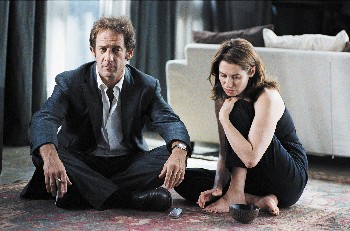 Turns out, they were right. For the most part. Here indeed is an intelligent thriller that takes a seemingly normal couple on a terrifying trip into thriller territory but bypasses any of the more obvious plot devices of that popular genre. No dead bodies, no world weary chain smoking detectives, no femme fatales. Sorry, kids. We’re talking domestic drama with a twist.
Turns out, they were right. For the most part. Here indeed is an intelligent thriller that takes a seemingly normal couple on a terrifying trip into thriller territory but bypasses any of the more obvious plot devices of that popular genre. No dead bodies, no world weary chain smoking detectives, no femme fatales. Sorry, kids. We’re talking domestic drama with a twist.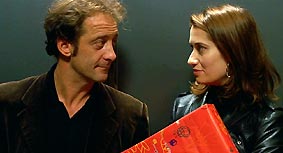
 For you see, the newly smooth faced Marc begins to become unglued when his wife fails to notice any difference, their friends at dinner make absolutely no comment on his new look and far worse for the stability of his own reality – vehemently deny the existence of any moustache in question.
For you see, the newly smooth faced Marc begins to become unglued when his wife fails to notice any difference, their friends at dinner make absolutely no comment on his new look and far worse for the stability of his own reality – vehemently deny the existence of any moustache in question.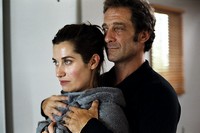 What first seems like a sick little in-joke between friends and lovers turns into a living hell for a man who begins to question his own memory, his own persona and ultimately his existence. All this might make for a cerebral or wordy existential non-drama in the hands of a lesser director, but Emmanuel Carrère in adapting his own novella to the silver screen is blessedly a visual stylist and assured hand at spinning a good yarn.
What first seems like a sick little in-joke between friends and lovers turns into a living hell for a man who begins to question his own memory, his own persona and ultimately his existence. All this might make for a cerebral or wordy existential non-drama in the hands of a lesser director, but Emmanuel Carrère in adapting his own novella to the silver screen is blessedly a visual stylist and assured hand at spinning a good yarn.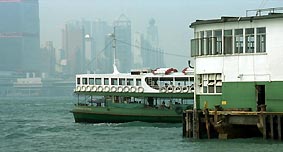 The film begins and ends with a visual of a body of water by night. While we could bandy about fancy phrases and psychological frippery about “memory being like water”, or the “ripples of memory” or “the washing of sins” . . . you get the point, don’t you? We simply fell in love with the director’s use of water as a visual metaphor for the unraveling of Marc’s sanity.
The film begins and ends with a visual of a body of water by night. While we could bandy about fancy phrases and psychological frippery about “memory being like water”, or the “ripples of memory” or “the washing of sins” . . . you get the point, don’t you? We simply fell in love with the director’s use of water as a visual metaphor for the unraveling of Marc’s sanity.  Once he reaches a breaking point in the scenario and attempts to reclaim his memory by abandoning his home to venture to the Far East – the film enters its most hypnotic phase. Marc’s complete devastation begins to manifest itself in a strange ritual of riding a ferry back and forth all day long staring at the rhythmic waters below and beginning to assume the air and appearance of a deranged vagrant.
Once he reaches a breaking point in the scenario and attempts to reclaim his memory by abandoning his home to venture to the Far East – the film enters its most hypnotic phase. Marc’s complete devastation begins to manifest itself in a strange ritual of riding a ferry back and forth all day long staring at the rhythmic waters below and beginning to assume the air and appearance of a deranged vagrant. Where the film takes us after his near climactic breakdown we will not reveal. Suffice to say that the mind is a very sensitive territory. The Hitchcockian aspects of this tidy little edge-of-your-seater are joyous in their simplicity. By taking a normal couple and infusing their everyday life with a mounting sense of terror, we are drawn into the proceedings and begin to feel Marc’s psychological claustrophobia. All in all a most satisfying journey into one’s man personal hell that began with the tiniest flick of a razor. Bless you all!
Where the film takes us after his near climactic breakdown we will not reveal. Suffice to say that the mind is a very sensitive territory. The Hitchcockian aspects of this tidy little edge-of-your-seater are joyous in their simplicity. By taking a normal couple and infusing their everyday life with a mounting sense of terror, we are drawn into the proceedings and begin to feel Marc’s psychological claustrophobia. All in all a most satisfying journey into one’s man personal hell that began with the tiniest flick of a razor. Bless you all!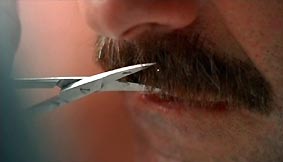 Directed by Emmanuel Carrère
Directed by Emmanuel Carrère
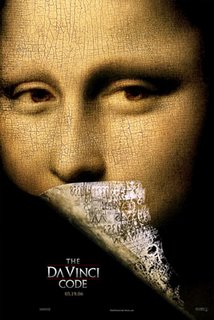 It was called “
It was called “ By now, most of you know that “The Da Vinci Code” is based on the potboiler goldmine penned or plundered (
By now, most of you know that “The Da Vinci Code” is based on the potboiler goldmine penned or plundered (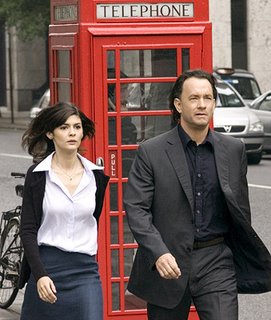 The film version of “The Da Vinci Code” is directed with a criminally sedate eye by Oscar winner
The film version of “The Da Vinci Code” is directed with a criminally sedate eye by Oscar winner  The plot is relatively simple and completely simple minded – a crazed
The plot is relatively simple and completely simple minded – a crazed 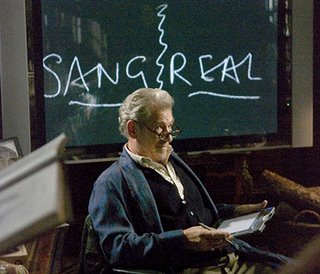 And oh, what a lengthy, chatty, non-linear, purloined and clumsy chase it is. The film version deserves credit for the top notch production values, fine use of real locations (our beloved Paris, Louvre, London, etc.) and in particular to the casting of two time Oscar nominee
And oh, what a lengthy, chatty, non-linear, purloined and clumsy chase it is. The film version deserves credit for the top notch production values, fine use of real locations (our beloved Paris, Louvre, London, etc.) and in particular to the casting of two time Oscar nominee 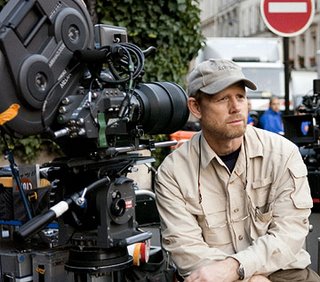 While we have absolutely no doubt to the capacity of the filmmakers to craft an exciting melodrama from various interwoven plotlines, we are left to ponder that perhaps the source material was too ripe for the transition. Certainly, Ron Howard has done good work in the past: his Oscar winning “
While we have absolutely no doubt to the capacity of the filmmakers to craft an exciting melodrama from various interwoven plotlines, we are left to ponder that perhaps the source material was too ripe for the transition. Certainly, Ron Howard has done good work in the past: his Oscar winning “ It also doesn’t help that Tom Hanks is about fifteen years past his prime as an action adventure hero. Sporting the worst hairdon’t this side of an
It also doesn’t help that Tom Hanks is about fifteen years past his prime as an action adventure hero. Sporting the worst hairdon’t this side of an For you see in order to help our hero Langdon with his chronic claustrophobia, our heroine Sophie recounts her parents’ death via a horrific car accident that left her with a wonderful parlor trick of “hands on healing”. She grasps his blubbery cheeks, the ones on his face thankfully and begins to weave her spell. The end result is so shocking visually we screamed out loud in horror. She resembled a
For you see in order to help our hero Langdon with his chronic claustrophobia, our heroine Sophie recounts her parents’ death via a horrific car accident that left her with a wonderful parlor trick of “hands on healing”. She grasps his blubbery cheeks, the ones on his face thankfully and begins to weave her spell. The end result is so shocking visually we screamed out loud in horror. She resembled a  Sadly, that scene was the most shocking and horrifying in the entire splash and dash murder mystery with a dab of fake religion tossed in. We were shocked to know from acquaintances (permanently dead to us now) that many of the sheep who flocked to their local B&N to purchase the original tome believe wholeheartedly in the twisting, turning and massacring of the history on display here. By playing freely with the real histories of
Sadly, that scene was the most shocking and horrifying in the entire splash and dash murder mystery with a dab of fake religion tossed in. We were shocked to know from acquaintances (permanently dead to us now) that many of the sheep who flocked to their local B&N to purchase the original tome believe wholeheartedly in the twisting, turning and massacring of the history on display here. By playing freely with the real histories of  While we understand that it may be “fun” to some sick individuals to shop their brief snippets of history from cheap airport mass paperbacks, they might actually try to crack open an honest portrayal of the times in question. Shame on them.
While we understand that it may be “fun” to some sick individuals to shop their brief snippets of history from cheap airport mass paperbacks, they might actually try to crack open an honest portrayal of the times in question. Shame on them. The only line concerning historical “evidence” that rang true to us was the slapping down of the ancient myth of
The only line concerning historical “evidence” that rang true to us was the slapping down of the ancient myth of 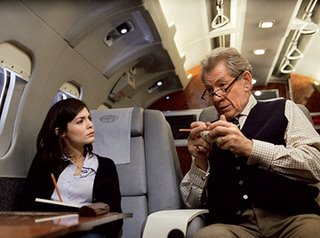 Back to the film. While pudgy runs-waddles thru the streets of the major capitals of Europe clasping Sophie’s paw as if it were part of his chicken dinner, we are forced to sit thru various lectures on fictionalized history that might have been interesting if they were true, and are only tolerable since most of them are delivered by the truly accomplished talents of Sir Ian McKellen. Sir Ian has such great fun with his role that it is far and away the only reason to sit thru two and a half hours of creaky melodrama.
Back to the film. While pudgy runs-waddles thru the streets of the major capitals of Europe clasping Sophie’s paw as if it were part of his chicken dinner, we are forced to sit thru various lectures on fictionalized history that might have been interesting if they were true, and are only tolerable since most of them are delivered by the truly accomplished talents of Sir Ian McKellen. Sir Ian has such great fun with his role that it is far and away the only reason to sit thru two and a half hours of creaky melodrama.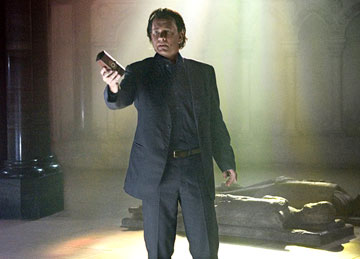 The pilfering and plundering of religious history might have made for an interesting storyline in the hands of an accomplished author. Dan Brown is not one. The film version of a pulp mystery might have made for an exciting thriller. “The Da Vinci Code” is definitely not one. If ever a script called for a pyrotechnical directorial style, this is it. Ron Howard, despite some wonderful films in his past, is simply not the visual stylist required to pull it off.
The pilfering and plundering of religious history might have made for an interesting storyline in the hands of an accomplished author. Dan Brown is not one. The film version of a pulp mystery might have made for an exciting thriller. “The Da Vinci Code” is definitely not one. If ever a script called for a pyrotechnical directorial style, this is it. Ron Howard, despite some wonderful films in his past, is simply not the visual stylist required to pull it off. Do yourselves a favor. Avoid “The Da Vinci Code”. The book and the movie. Go
Do yourselves a favor. Avoid “The Da Vinci Code”. The book and the movie. Go
 “Lemming” is a terrifically entertaining and twisted little thriller that delves into the dank and festering underbelly of humanity. The suburban couple. Our beloved
“Lemming” is a terrifically entertaining and twisted little thriller that delves into the dank and festering underbelly of humanity. The suburban couple. Our beloved  The elder couple is portrayed by the accomplished
The elder couple is portrayed by the accomplished  We were completely beguiled and ready for a rip roaring domestic drama. And then we remembered that this was a thriller. Into the mix, arrived a wildly obtuse bit of symbolism that either works for the audience or doesn’t. It has to do with the title of the film.
We were completely beguiled and ready for a rip roaring domestic drama. And then we remembered that this was a thriller. Into the mix, arrived a wildly obtuse bit of symbolism that either works for the audience or doesn’t. It has to do with the title of the film.  Once the little rodent is discovered, their lives kick into a fast track downwards spiral that offers some superb moments for the actors. Charlotte Rampling is absolutely breathtaking as the shattered Alice. While her role is not the lead, it consumes all scenes and players around her. Which would be a terrible thing if the film’s central conceit did not rely so heavily on her strong presence. For you see, gentle readers, Alice is a woman who will stop at nothing in order to make her deceptive husband pay for the years of emotional abuse he has heaped upon her. Well, certainly from her perspective.
Once the little rodent is discovered, their lives kick into a fast track downwards spiral that offers some superb moments for the actors. Charlotte Rampling is absolutely breathtaking as the shattered Alice. While her role is not the lead, it consumes all scenes and players around her. Which would be a terrible thing if the film’s central conceit did not rely so heavily on her strong presence. For you see, gentle readers, Alice is a woman who will stop at nothing in order to make her deceptive husband pay for the years of emotional abuse he has heaped upon her. Well, certainly from her perspective. Which is a notion this film takes to heart. Perception. The roles we are expected to play as boss / employee, husband / wife, parent / child. All of them become inverted and twisted in this domestic drama with more than a few tinges of the supernatural. Thankfully, it never descends into “Slasher / Killer / Zombie” territory, and the most horrifying elements depend entirely on one’s perspective. Is Bénédicte acting strangely? Or is Alain reading too much into her actions? What exactly happened between Alice and Richard? Between Alice and Alain? Between Alice and Bénédicte?
Which is a notion this film takes to heart. Perception. The roles we are expected to play as boss / employee, husband / wife, parent / child. All of them become inverted and twisted in this domestic drama with more than a few tinges of the supernatural. Thankfully, it never descends into “Slasher / Killer / Zombie” territory, and the most horrifying elements depend entirely on one’s perspective. Is Bénédicte acting strangely? Or is Alain reading too much into her actions? What exactly happened between Alice and Richard? Between Alice and Alain? Between Alice and Bénédicte? To say that the plot gets thick with tension and fear is an understatement. Credit the four lead actors for their fantastic turns. Charlotte Gainsbourg has always had such a delicate beauty and grace about her that it was revelatory to watch her dabble in the darker aspects of the human soul. Her character takes on the mantle of Alice’s pain in some very unexpected ways. We loved watching this seemingly benign and doting bourgeois housewife dip into a macabre and dangerous world.
To say that the plot gets thick with tension and fear is an understatement. Credit the four lead actors for their fantastic turns. Charlotte Gainsbourg has always had such a delicate beauty and grace about her that it was revelatory to watch her dabble in the darker aspects of the human soul. Her character takes on the mantle of Alice’s pain in some very unexpected ways. We loved watching this seemingly benign and doting bourgeois housewife dip into a macabre and dangerous world. André Dussollier is perfectly cast as the cold and domineering patron. The level of his debauchery flies directly in the face of his cool exterior and calm controlling manner at work.
André Dussollier is perfectly cast as the cold and domineering patron. The level of his debauchery flies directly in the face of his cool exterior and calm controlling manner at work. And finally, but certainly not least, Laurent Lucas as Alain delivers the central performance as the beleaguered husband and employee to perfection. Never quite sure why his world is unraveling or what he can possibly begin to do to stop the bleeding – he maintains a believability that is enviable.
And finally, but certainly not least, Laurent Lucas as Alain delivers the central performance as the beleaguered husband and employee to perfection. Never quite sure why his world is unraveling or what he can possibly begin to do to stop the bleeding – he maintains a believability that is enviable. Credit must go to co-scenarist and director Dominik Moll, who has already shown great skill and aplomb at handling such dark material. His previous thriller, “
Credit must go to co-scenarist and director Dominik Moll, who has already shown great skill and aplomb at handling such dark material. His previous thriller, “ Monsieur Moll also shows a fine grasp of tidying up any loose threads, while managing not to spell out all the details. We appreciate greatly his sense of calm in the storm that never condescends to the audience. A lesson that many American directors of similar themes should take to heart. “Lemming” is a blissfully intelligent and tense thriller that should be the perfect antidote to your usual summer nitwit fare. Do yourselves a favor, and go explore it’s macabre little world. You’ll be glad we sent you. Bless you all!
Monsieur Moll also shows a fine grasp of tidying up any loose threads, while managing not to spell out all the details. We appreciate greatly his sense of calm in the storm that never condescends to the audience. A lesson that many American directors of similar themes should take to heart. “Lemming” is a blissfully intelligent and tense thriller that should be the perfect antidote to your usual summer nitwit fare. Do yourselves a favor, and go explore it’s macabre little world. You’ll be glad we sent you. Bless you all!
